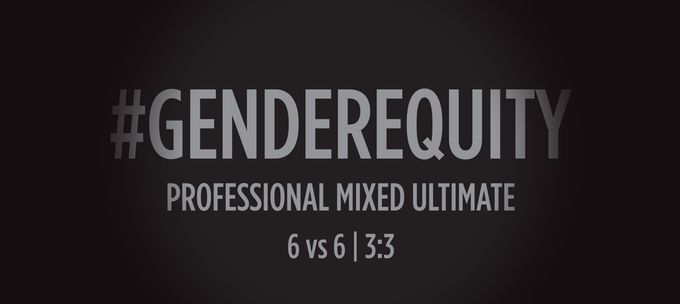In early 2018, a new professional ultimate league was proposed that would advance gender equity in the sport with great symbolism for youth players. If you’re a coach, parent, or player that would like to explore how professional mixed ultimate could inspire and accelerate youth development, then you should back the United Ultimate League (UUL) Kickstarter — a community fundraiser that is now in its final stages (end of February, 2018).
If you can’t contribute financially (and even if the Kickstarter fails) it’s worth understanding the suite of proposed ideas — many of which have implications for the development of youth ultimate in the United States. This blog post is my attempt to pull together salient details about the proposed league. I hope it will promote discussion of gender equity and professional ultimate, particularly in Seattle where the UUL campaign and ideas seem to have received little attention, possibly because the league proposal has been led by Todd Curran, the CEO of the Savage ultimate apparel company which is based on the East coast.
Youth benefits
From my perspective as a youth coach (elementary and middle school) and a father of both a female and male player, the idea of regular, local, high-level mixed ultimate games in major U.S. cities is most attractive for one key reason: the youngest kids learn to play co-ed (in elementary school) and it would be more meaningful if there were both women and men on the field when these youth first watch a professional game. We liked and supported the MLU Rainmakers and we love and support the AUDL Cascades — especially their impressive ramp up of youth-fostering activities over the last couple years. Live-streamed mixed games from USAU club championships are great, too.
But only a mixed professional team could inspire all of our youngest players equally, and rid us of the dissonance we feel when they earnestly ask upon first viewing the professional field “Wait, where are the girls?”
The UUL Kickstarter site makes two good points about additional benefits the new league could offer to youth ultimate:
Why 6v6 and not 8v8?We chose the 6v6 style and slightly smaller Ultimate field to follow with our core values: gender equity and youth development. Having a smaller field means it’s harder to reach top speed. Also with fewer players on the field, it makes “looking off passes” less advantageous. On the youth side, the smaller field allows for two fields to fit on one soccer field. This increases playing opportunities and keeps costs low.
Equal-gender 6-versus-6 format
The UUL proposes 6-person teams (instead of the adult standard of 7) with equal number of players who identify as men or women. (How genderqueer players would/could play hasn’t been specified, as far as I’ve seen.) The Kickstarter site points out that if this format became accepted and popular, youth teams could also convert to 6v6.
In Seattle the elementary league has transitioned to 5v5 over the past two springs, in part because the format generally means more touches per player and less complexity on the field (making it easier to learn to create and take space, and safer by decreasing the odds of a collision). Perhaps middle school leagues could start playing coed 6v6 which would not only match the UUL format, but also provide a transition to learning 7v7 in high school.
Or maybe we would optimize development by staying with 5v5 through middle school and transitioning to 6v6 in high school? As males catch up developmentally with girls in middle and high school, youth players might also benefit from the UUL’s concept of promoting gender equity by using the smaller field dimensions to lower the likelihood of players hitting their top speeds (thereby decreasing the risk of more-injurious collisions and de-emphasizing the speed differentials between genders).
Smaller field
In Seattle, where field access is an on-going and increasing problem, it would be strategic to shift the game to a smaller field (with dimensions that fit twice within a soccer or football footprint). This is part of the reason elementary teams shifted to 5v5. If both middle and high school leagues switched to 6v6, we could effectively double their supply of fields instantly.

The field size is 70×40 yards overall with 20 yard endzones, dimensions which have been tested successfully in flatball, another ultimate variant that has been sponsored by Savage Ultimate. Since the standard soccer field width is 70 yards, a soccer or football pitch could accommodate two of these new ultimate fields, with a generous 10-20 yards for a safe sideline between fields.
Other aspects of the UUL: good, bad, and not yet defined…
The positive implications for youth ultimate I’ve outlined above should be enough to inspire most ultimate community members to back the UUL Kickstarter. There are, however, lots of other interesting ideas that the proposed league has offered for our consideration. And there are some areas of ambiguity where the community has asked for and/or could provide innovative solutions.
Since the sources of information and discussion about the league are pretty spread out, below I’ve distilled the ones I found most helpful in answering questions I had after reading through the Kickstarter site.
https://www.kickstarter.com/projects/unitedultimateleague/united-ultimate-league/
Resources, interviews, discussions
- Jan 15 announcement
- Jan 15 Skyd Magazine Q&A interview with Todd Curran
- Jan 15 Ultiworld article
- Deep look podcast:
More links to explore:
- Reddit
- Ask me anything (AMA) with Todd Curran
- Statement
United Ultimate League Prepares for 2019 Launch | Introducing Ultimate’s First Professional Mixed League
byu/UnitedUltimateLeague inultimate




